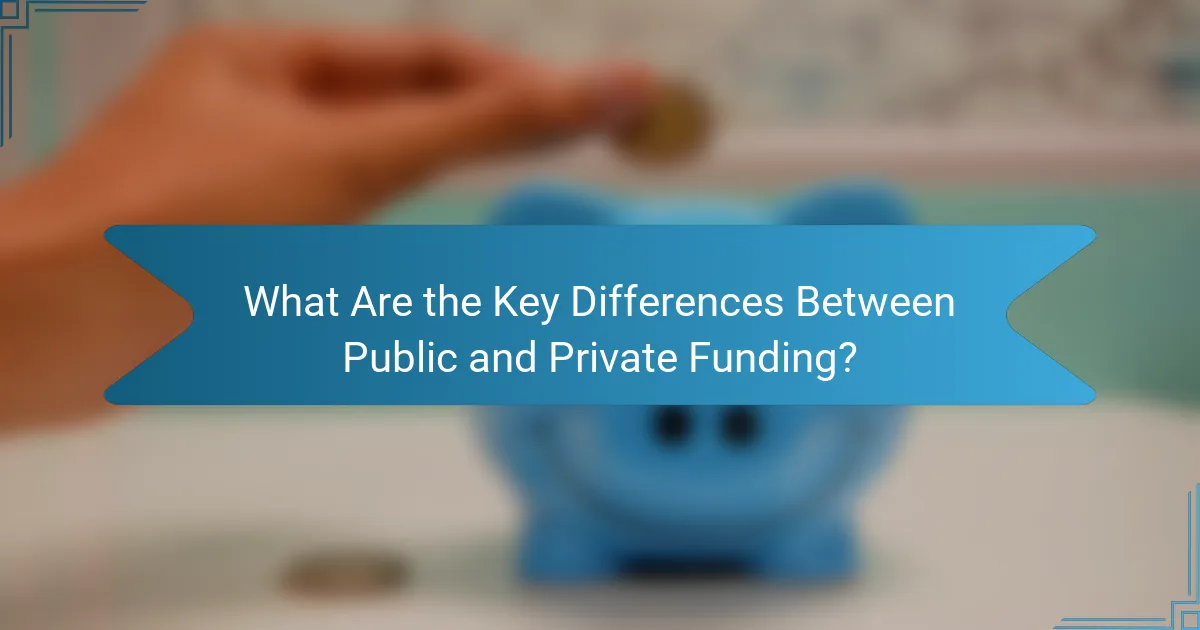When considering funding options for a project, it’s essential to understand the differences between public and private funding sources. Public funding, sourced from government entities, is best suited for initiatives that align with community needs and require substantial investment. In contrast, private funding, which comes from individuals and corporations, is ideal for projects that demand quick capital and have high growth potential, often favored by startups seeking to retain operational control.

What Are the Key Differences Between Public and Private Funding?
Public funding typically comes from government sources, while private funding is sourced from individuals, corporations, or non-profits. Understanding these differences is crucial for determining which type of funding aligns best with your project’s goals and requirements.
Public funding sources
Public funding sources include government grants, subsidies, and loans provided by local, state, or federal agencies. These funds are often allocated for specific projects that align with public interests, such as education, infrastructure, or healthcare.
Examples of public funding include the Small Business Administration (SBA) loans in the United States and European Union grants for research and innovation. These sources may require detailed proposals and compliance with regulations.
Private funding sources
Private funding sources encompass investments from individuals, venture capitalists, angel investors, and private foundations. This type of funding is often more flexible and can be tailored to the specific needs of a project.
For instance, a tech startup might seek venture capital to scale its operations quickly, while a non-profit may rely on donations from private individuals. The application process is generally less bureaucratic compared to public funding.
Comparison of funding structures
Public funding often comes with strict guidelines and reporting requirements, which can limit project scope but ensure accountability. In contrast, private funding may offer more freedom in project execution but can come with expectations for high returns on investment.
Additionally, public funding is usually slower to secure due to lengthy approval processes, while private funding can be accessed more rapidly, enabling quicker project initiation.
Impact on project scope
The choice between public and private funding can significantly impact the scope of a project. Public funding often mandates adherence to specific objectives, which can narrow the project’s focus but ensure alignment with community needs.
Private funding, however, allows for broader project scopes and innovative approaches, as investors may be more willing to take risks on untested ideas. This flexibility can lead to more creative solutions but may also result in a lack of oversight.
Regulatory considerations
Public funding is subject to various regulations and compliance requirements, which can include audits and performance assessments. These regulations are designed to ensure that public funds are used effectively and transparently.
On the other hand, private funding typically has fewer regulatory hurdles, allowing for a more streamlined process. However, investors may impose their own terms and conditions that must be carefully negotiated to avoid future conflicts.

When Should You Choose Public Funding?
Public funding is ideal when your project aligns with government priorities or addresses community needs. It is often used for initiatives that require significant investment but may not attract private funding due to perceived risks or lower returns.
Best scenarios for public funding
Public funding is best suited for projects that serve the public good, such as infrastructure development, education, and healthcare initiatives. These projects typically benefit from government support due to their potential to improve community welfare and economic stability.
Additionally, public funding is advantageous for research and development projects that may not yield immediate financial returns but contribute to long-term societal advancements. Examples include environmental sustainability projects and public health research.
Advantages of public funding
One of the main advantages of public funding is access to larger financial resources without the burden of repayment, which is common in private funding scenarios. This allows for more extensive project scopes and longer timelines.
Public funding often comes with additional support, such as technical assistance and networking opportunities, which can enhance project success. Moreover, projects funded by public sources may benefit from increased credibility and visibility.
Examples of successful public funding projects
Successful public funding projects include the construction of public transportation systems, such as subways and light rail networks, which are often financed through government grants and bonds. These projects improve urban mobility and reduce traffic congestion.
Another example is the funding of renewable energy initiatives, like solar and wind farms, which receive government subsidies to promote clean energy adoption. These projects not only contribute to environmental goals but also create jobs and stimulate local economies.

When Is Private Funding More Suitable?
Private funding is often more suitable for projects that require quick capital, have high growth potential, or involve innovative ideas that may not attract public funding. This type of financing is typically favored by startups and businesses seeking to maintain control over their operations while accessing necessary resources.
Best scenarios for private funding
Private funding is ideal for early-stage companies that need to scale rapidly without the constraints of public funding processes. It is particularly beneficial for sectors like technology, biotech, and creative industries where innovation is key and traditional funding sources may be limited.
Additionally, private funding works well when a project has a clear path to profitability and can demonstrate strong market demand. Investors are often attracted to ventures that show potential for significant returns within a short timeframe.
Advantages of private funding
One major advantage of private funding is the speed of access to capital, allowing businesses to act quickly on opportunities. Unlike public funding, which can involve lengthy approval processes, private investors can make decisions rapidly.
Another benefit is the flexibility in terms and conditions. Private investors often negotiate terms that align with the specific needs of the business, which can lead to more favorable arrangements compared to rigid public funding criteria.
Examples of successful private funding projects
Numerous startups have thrived through private funding, such as tech companies that secured venture capital to develop innovative products. For instance, companies like Airbnb and Uber initially relied on private funding to disrupt their respective industries and achieve rapid growth.
In the biotech sector, firms often attract private investment to fund research and development phases that are too risky for public funding. These projects can lead to groundbreaking therapies and significant financial returns for investors when successful.

What Are the Costs Associated with Each Funding Type?
The costs associated with public and private funding vary significantly based on the source, structure, and intended use of the funds. Public funding often comes with regulatory compliance costs, while private funding may involve higher interest rates or equity dilution.
Cost structures of public funding
Public funding typically involves lower direct costs, as it often comes from government grants or subsidies that do not require repayment. However, organizations must consider the indirect costs, such as administrative expenses and compliance with regulations, which can be substantial.
For example, applying for public grants may require detailed reporting and project oversight, which can lead to additional staffing costs. It’s essential to factor in these potential expenses when evaluating public funding options.
Cost structures of private funding
Private funding usually entails higher costs due to interest payments or equity stakes taken by investors. These costs can vary widely depending on the investor’s terms, which may include performance milestones or profit-sharing agreements.
Organizations should carefully assess the long-term financial implications of private funding, including potential dilution of ownership and the pressure to deliver returns quickly. Comparing the total cost of capital from private sources against the benefits gained is crucial for informed decision-making.

How Do Public and Private Funding Affect Project Outcomes?
Public and private funding can significantly influence project outcomes by shaping resources, timelines, and overall success. Public funding often comes with regulatory requirements and longer approval processes, while private funding typically offers more flexibility and quicker access to capital.
Impact on project timelines
Public funding usually involves a lengthy application and approval process, which can delay project initiation. For example, government grants may require extensive documentation and compliance checks, potentially extending timelines by several months.
In contrast, private funding can expedite project timelines due to fewer bureaucratic hurdles. Investors often seek quick returns, which can motivate faster decision-making and implementation. Projects funded privately may start within weeks rather than months.
Impact on innovation and flexibility
Public funding often emphasizes accountability and adherence to established guidelines, which can limit innovation. Projects may need to align closely with governmental priorities, reducing the scope for creative approaches.
Private funding, however, tends to encourage innovation and flexibility. Investors are often more willing to take risks on unproven ideas, allowing projects to pivot and adapt as needed. This can lead to more groundbreaking solutions and faster adjustments to market demands.

What Criteria Should You Consider When Choosing Funding?
When choosing funding, consider factors such as project goals, availability of funds, and stakeholder involvement. Each criterion plays a crucial role in determining which funding source aligns best with your project’s needs.
Project goals and objectives
Your project goals and objectives should guide your funding choice. Public funding often supports projects with broad social benefits, while private funding may focus on specific outcomes that align with investor interests.
For example, if your goal is to enhance community infrastructure, public funding might be more suitable. Conversely, if your objective is to develop a new technology, private funding could provide the necessary resources and flexibility.
Funding availability and accessibility
Assessing funding availability and accessibility is vital. Public funding sources, such as government grants, may have strict application processes and eligibility criteria, while private funding can be more flexible but competitive.
Consider the time and effort required to secure each type of funding. Public funding applications often take longer to process, whereas private investors may respond more quickly but require thorough proposals and pitches.
Stakeholder involvement
Stakeholder involvement can significantly influence your funding decision. Public funding typically requires engagement with community stakeholders and adherence to regulatory requirements, ensuring that the project aligns with public interests.
In contrast, private funding may prioritize relationships with investors and their expectations. Understanding the interests of your stakeholders can help you choose the funding source that best supports your project’s vision and community impact.



